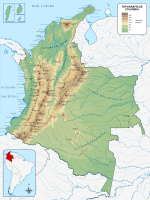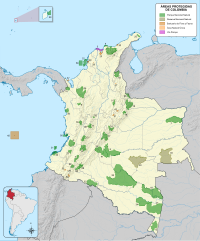| Cerulean Warbler Bird Reserve | |
|---|---|
| La Reserva Natural de las Aves Reinita Cielo Azul | |
| Location | Santander Department, Colombia |
| Nearest city | Bucaramanga |
| Area | 545 acres (221 ha) |
| Established | 2005 |
| Governing body | Fundación ProAves American Bird Conservancy |
Cerulean Warbler Bird Reserve, known in Spanish as Reserva Natural de las Aves Reinita Cielo Azul, is a nature reserve near Bucaramanga in central Colombia.[1] The reserve is set among oak forest on the eastern slopes of the Magdalena River. It measures 545 acres (221 ha) and adjoins the Yariguíes National Park.[2]
The reserve was founded in 2005 by Fundación ProAves, a non-profit environmental organization that owns and manages several reserves in Colombia, with the assistance of the American Bird Conservancy. It was established to provide an area of protected habitat for migratory birds from North America such as the cerulean warbler as well as locally threatened species.[2] The reserve has incorporated a 15 hectares (37 acres) coffee farm, producing shade-grown coffee which it promotes and sells as conservation-friendly Cerulean Warbler Coffee to cover the operating costs of the reserve.[3]
YouTube Encyclopedic
-
1/1Views:1 945
-
Protecting Cerulean Warblers
Transcription
My name is Than Boves. I am a doctoral candidate in the Department of Forestry, Wildlife and Fisheries at the University of Tennessee. I've been fascinated by, birds in particular, but wildlife in general, since I was very young. I went on a family vacation in Newfoundland. In Newfoundland, it happened that my parents had a pair of binoculars and I happened to look at a yellow-rumped warbler. I remember looking through the binoculars and looking at this warbler and being absolutely amazed about how colorful and how beautiful this bird was. And I remember being hooked at that moment pretty much. After that, everywhere I went, I would carry my binoculars with me and tried to identify every species saw there. And it just kind of grown from there. That's what brings me to the University of Tennessee today, to study the Cerulean Warbler and help conserve its habitat and give it a chance for the future. Cerulean Warblers are incredibly unique, small neotropical migrants. They are in the family Parulidae. They weigh about nine grams which is a little less than two nickels. They have a bright blue coloration on their back. They also have clear white undersides with a black breast stripe. And that black breast stripe can vary from being almost non-existant to being quite large. There aren't many other species that have the color patterns of Cerulean Warblers, especially in their family and especially inhabiting the canopy like they do. The U.S. Fish and Wildlife Service did find reason to believe that the population is decreasing rapidly, and they then decided that it is better to spend a little time doing a little more research and finding out how close to extinction Cerulean Warblers are. And in the last 10 years, a lot of research has been done on Cerulean Warblers. What we've found is they are still declining, and they are not extremely close to extinction right now, but they are definitely on the verge of being a federally endangered species. The Cumberland mountains are exceptionally important to the Cerulean Warbler. If you wanted to protect the Cerulean Warbler and you had to choose one location on earth, you would choose the Cumberland mountains of East Tennessee. I really think it's important to understand how important they are to Cerulean Warblers, and while there are many other species that inhabit the Cumberland mountains (and the forest is important to them as well), there is no species that relies on the Cumberland mountains in the way that the Cerulean Warbler does, with 25% of their population inhabiting the small area in northern Tennessee and southern Kentucky. I think its just important to have biodiversity for the sake of biodiversity, but also from a human perspective, all these species are interconnected. All of them play a role in the ecosystems that we rely on for survival. I think the world would be a much less enjoyable place to live in if we didn't have the multitude of avian species and species in general that we do. We are extremely lucky to live on an Earth with this many species and I think it's important we help protect and conserve them both for their sake and our own. -
Birds
Some 270 bird species have been recorded from the reserve. As well as the cerulean warbler, critically endangered local birds found there include the gorgeted wood-quail, chestnut-bellied hummingbird and mountain grackle. Other threatened species include the rusty-faced parrot, white-mantled barbet, black inca, Upper Magdalena tapaculo, turquoise dacnis and the recurve-billed bushbird. The Yariguies brush-finch is a new subspecies recently discovered just outside the reserve. Other animals of conservation interest include the spectacled bear, crab-eating fox and Santander poison dart frog.
Access
Accommodation is available at the reserve, which is two hours by road from Bucaramanga to San Vicente, and twenty minutes by 4WD vehicle from San Vicente up to the reserve. The lodge is 1,400 metres (4,600 ft) above sea level.
References
- ^ American Birding Association (2007). Birding. Vol. 39. American Birding Association. p. 225. Retrieved 4 August 2011.
- ^ a b "Cerulean Warbler Bird Reserve". Conservation Birding. American Bird Conservancy. 2009. Retrieved 2011-08-04.
- ^ "Cerulean Warblers and shade coffee". Coffee & Conservation. Retrieved 2010-05-25.


